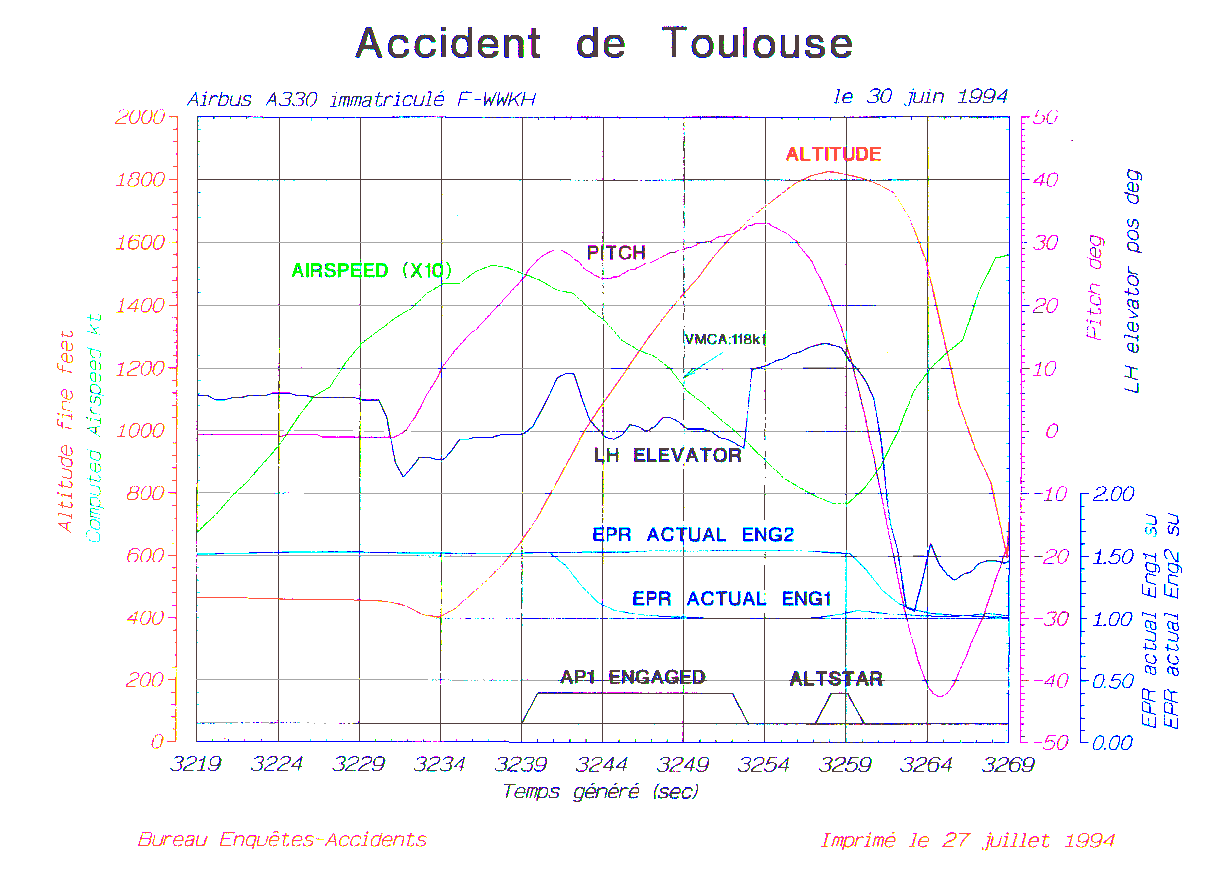A330 test flight accident in 1994
Guest
Posts: n/a
Guest
Posts: n/a
Air et Cosmos, 11-24 Juillet 1994, p15, contains an extensive report on the A330 accident of 30 June 1994 by Jean-Pierre Casamayou. The new info is highly relevant, and implies that control of the aircraft was lost while the aircraft was under automatic control. This is the first case, to my knowledge, in which this has been proved to have happened to Airbus aircraft, without any concomitant pilot error. Sadly, the test pilots allowed the departure from control to continue for up to 12 seconds in order to analyse the incident, the delay was fatal.
The autopilot was using experimental software. This A330 was undergoing a flight test required for certification of the autopilot for Category III operations with Pratt and Whitney 4168 engines (the other A330's already in operation use CF6-80E1's, and such equipment has already been through this particular flight test sequence). Category III operations mean use of the autopilot for landing, up to and including main gear on the runway, and requires special certification of both aircraft and crew. It follows that a Category III operation can potentially be aborted, i.e. the pilots can select go-around while under autopilot contol, with the main gear on the runway, and in the worst case an engine can fail at this point. One can see why it's required to conduct this test from an actual takeoff, rather than at altitude.
The flight was supposed to test the mode SRS (speed reference system) of the autopilot, which should control the speed and angle of attack (AoA) of the aircraft in case of an engine-out. AoA is defined to be the angle that the wing makes with the undisturbed airflow in front of the wing. The test was performed at rearmost center-of-gravity.
Following is a translation of a continuous fragment of the article. `V-speeds', defined in FAR Subchapter A Part 1 Para 1.2 for those in the US. V_1 is takeoff decision speed (the speed at which the decision is made to abort or to continue takeoff in the case of engine failure); V_R is rotation speed (the speed at which the pilot commands nose-up); V_2 is takeoff safety speed (the speed at which the airplane may takeoff safely, even with one motor out); V_{mca} is the minimum single-engine control speed (the speed at which control of the aircraft may be maintained with one engine out).
[begin translation]
The takeoff (V_1 = V_R = 126kts and V_2 = 135kts) took place at 136kts, 25 seconds after full power was arrived at (`la mise en plein piussance des moteurs'], then the aircraft took its speed of climb of 150 kts. After the takeoff, an altitude of 600m QNH (roughly 460m QFE) was selected on the flight director FCU. This means that the aircraft should restore level flight [`retablir en palier'] at 450m from the ground.
Conforming to the test order, the pilot attained a speed of 150 kts, and 28 degrees AoA in order to maintain this speed. Six seconds after takeoff, the autopilot was engaged, then the left engine retarded and the corresponding hydraulic pump cut to simulate a complete failure of the left engine. As predicted, the AoA began to diminish and passed from 29 degrees to 25 degrees, the limit authorised by the FMGS (Flight Management Guidance System) which protects the flight envelope. But quickly, because of the low altitude selected on the FCU, the autopilot departed from mode SRS and entered mode ALT-STAR, the mode for acquisition and retention of altitude, in which mode the autopilot tries to attain altitude as quickly as possible, without taking into account the limiting conditions that the airplane was in: rearmost CoG, one engine retarded and the other at full power, high `incidence. Result: the AoA started to increase again, and the speed decreased extremely quickly [`brutalement'].
The flight team noted immediately the anomaly, but purposely let the situation degrade for about 12 seconds, in order to analyse it better, as is their role. The AoA attained 33 degrees with speed decaying to 100kts, which is 18kts less than V_{mca}, the minimum single engine control speed . At this moment, the pilot disconnected the autopilot and took over control. But the speedcontinued to decrease. At about 90 kts, 28kts less than V_{mca}, the aircraft departed in a stall [`part en decrochage'] to the left with an angle of bank [`angle de roulis'] which attained 110 degrees.
The pilot reacted quickly and well in retarding the right engine then bringing the wings horizontal. Unfortunately, because of the low altitude and fast rater of descent, he couldn't avoid impact with the ground, 35 seconds aftertakeoff.
[end translation]
COMMISSION D'ENQUETE SUR L'ACCIDENT SURVENU LE 30 JUIN 1994 A TOULOUSE-BLAGNAC (31) A L'AIRBUS A330 Nš42 D'AIRBUS INDUSTRIE IMMATRICULE FWWKH RAPPORT PRELIMINAIRE
TRANSCRIPTION DU C.V.R





